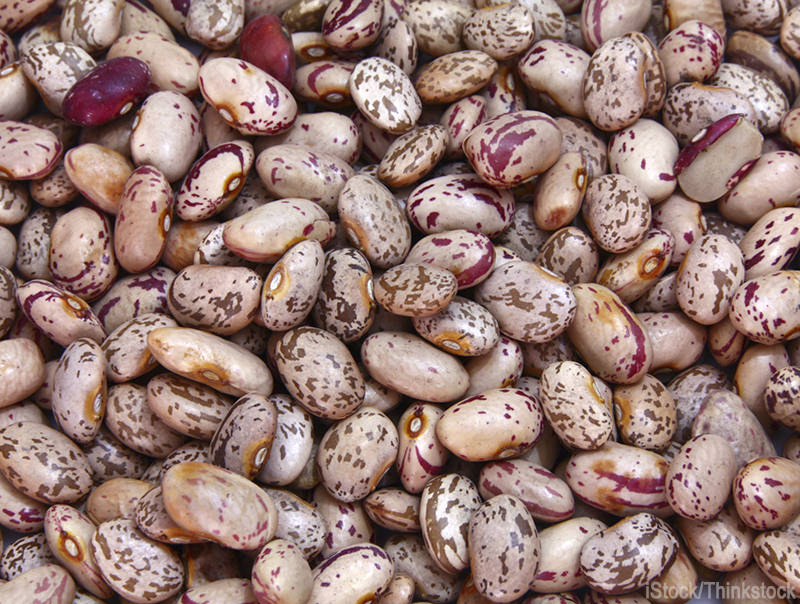

Of all the crops I plant in my garden each year—and there’s a lot—I’d have to say heirloom beans rank among my favorites. I love the dizzying array of colors, patterns, flavors and types, and the ancient art of harvesting dry beans to save for seed at the end of the season.
In my quest to fully explore the wide world of heirloom beans, I’ve grown countless varieties over the years. Some have been viewed as unsuccessful experiments (Lazy Housewife, anyone?), while others have become cherished varieties that merit a place in the garden each year. Here are 6 must-grow heirloom beans that will make your garden a happier place this year.
1. Hidatsa Shield Figure
I promised myself that I wouldn’t put these beans in any particular order of preference, but I think I’m subconsciously putting this one at the top because it’s my favorite. Hidatsa Shield Figure (pictured above) is an old pole-bean variety associated with the Hidatsa tribe of North Dakota. It’s one of the varieties described in Buffalo Bird Woman’s Garden by Gilbert Wilson (Minnesota Historical Society Press, 1987) and was included in Slow Food USA’s Ark of Taste in 2005.
Patterned in beautiful shades of browns and white, Hidatsa beans are nearly double the size of black beans. The variety is a prolific producer, and the vines like to climb, so trellising is important. You can even direct-sow them into the ground near sunflowers or corn to use as a natural trellis. The dried beans cook up large and have a creamy texture. Use them in soups or as a substitute for anything where you’d use pinto or white beans.
2. Dragon’s Tongue

The Dragon’s Tongue wax bean is remarkable and deserving of as much praise as I can give it. A bush variety, it’s an above-average producer of tender, 7-inch-long pods that can be used as both a snap and a shelled bean. My favorite part of this variety is its beautiful purple-and-cream-mottled pods: They make a gorgeous accent in the garden, but be aware, the purple fades with cooking. Their flavor is beyond compare, described as peppery with a fruity aftertaste. Use them within a day or two of harvesting to maximize their flavor potential.
If you can bear to part with any of your harvest, which is understandably tough to do, these beans make a big splash at the farmers market and are of interest to gourmet chefs.
3. Speckled Cranberry

I’m admittedly partial to beans with pretty colors and patterns, and that’s probably why the Speckled Cranberry pole bean remains one of my perennial favorites. As its name indicates, this prolific variety produces beautiful red-speckled beans and pods each year. Speckled Cranberry has nearly two centuries of history in America, having been brought to America from England in the 1820s. Like Dragon’s Tongue, it can be used both as a nearly stringless snap bean or as a shell bean. When cooked, they have a creamy texture and nutty flavor. Versatile, productive, and beautiful—what more could you want out of a bean?
4. Royalty Purple Pod
Vividly rich with vibrant deep-purple coloring, these exquisite snap beans more than live up to their royal name. A bush variety—though you’ll find a Purple Pod pole bean, as well—it produces 4- to 6-inch, slightly curved pods. They have a delightful meaty flavor, though when cooked, the purple turns green. Anecdotally, Royalty Purple Pod seems to be more resistant to disease than some of the other varieties, which is always a bonus. They germinate well in cool soil, so it’s possible to get an early start with these beans.
5. Mayflower
This beautiful red-and-white pole bean is said to have come over on the Mayflower in the 1600s, though other sources point to long-time use by the Amish. Regardless of the lore you choose to believe, it has survived a long history and now holds an honored spot on the Slow Food USA Ark of Taste. The beans are a staple crop in the Carolinas, and I’m disappointed that my chilly zone 3 isn’t conducive to growing them. The small, square-ish beans have a slightly sweet flavor that can be used in relishes, salsas and salsas, though as a stringless variety, they also have historic use as green beans.
6. Painted Pony

OK, so I love the name—what’s better than a pony?—but I also love the color and pattern of these charming, versatile brown-and-white kidney-shaped beans, which retain their color in cooking. Use them at the snap stage or wait for them to dry. The bush habit makes them a super choice for gardeners working in small spaces, and their impressive productivity means that you’ll get a lot of bang for your buck.
Which heirloom bean variety is your favorite to grow?
Find more about beans on HobbyFarms.com:
- How to Grow Beans
- Crop Profile: Pole Beans
- How to Prepare Dried Beans
- Red and Green Yard Long Beans
- Taccole: My Favorite Green Beans
About the Author: Samantha Johnson is the author of several books, including The Beginner’s Guide to Vegetable Gardening, (Voyageur Press, 2013). She lives on a former dairy farm in northern Wisconsin with a Pembroke Welsh Corgi named Peaches and writes frequently about pets, gardening, and farm life. Visit her online portfolio.




